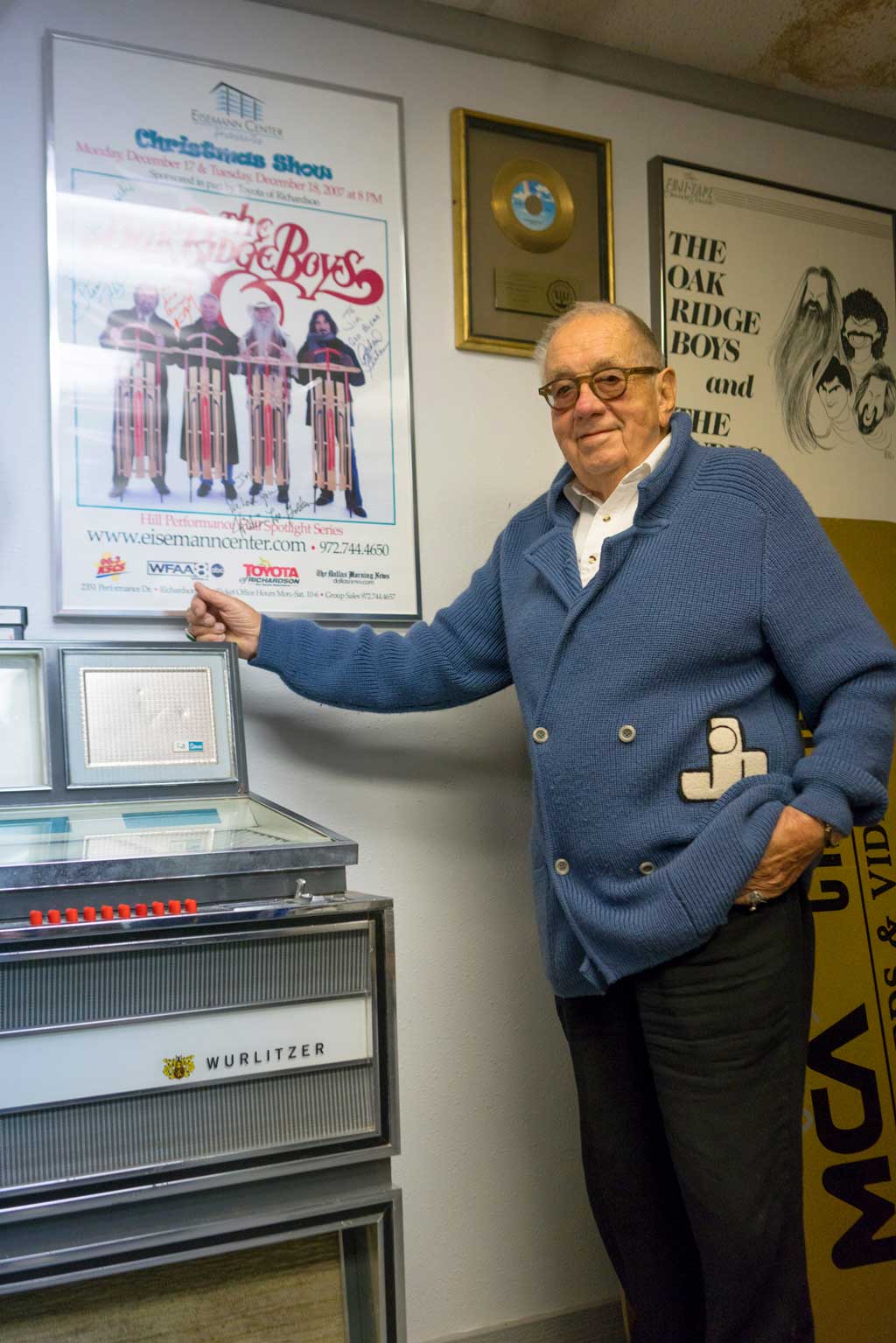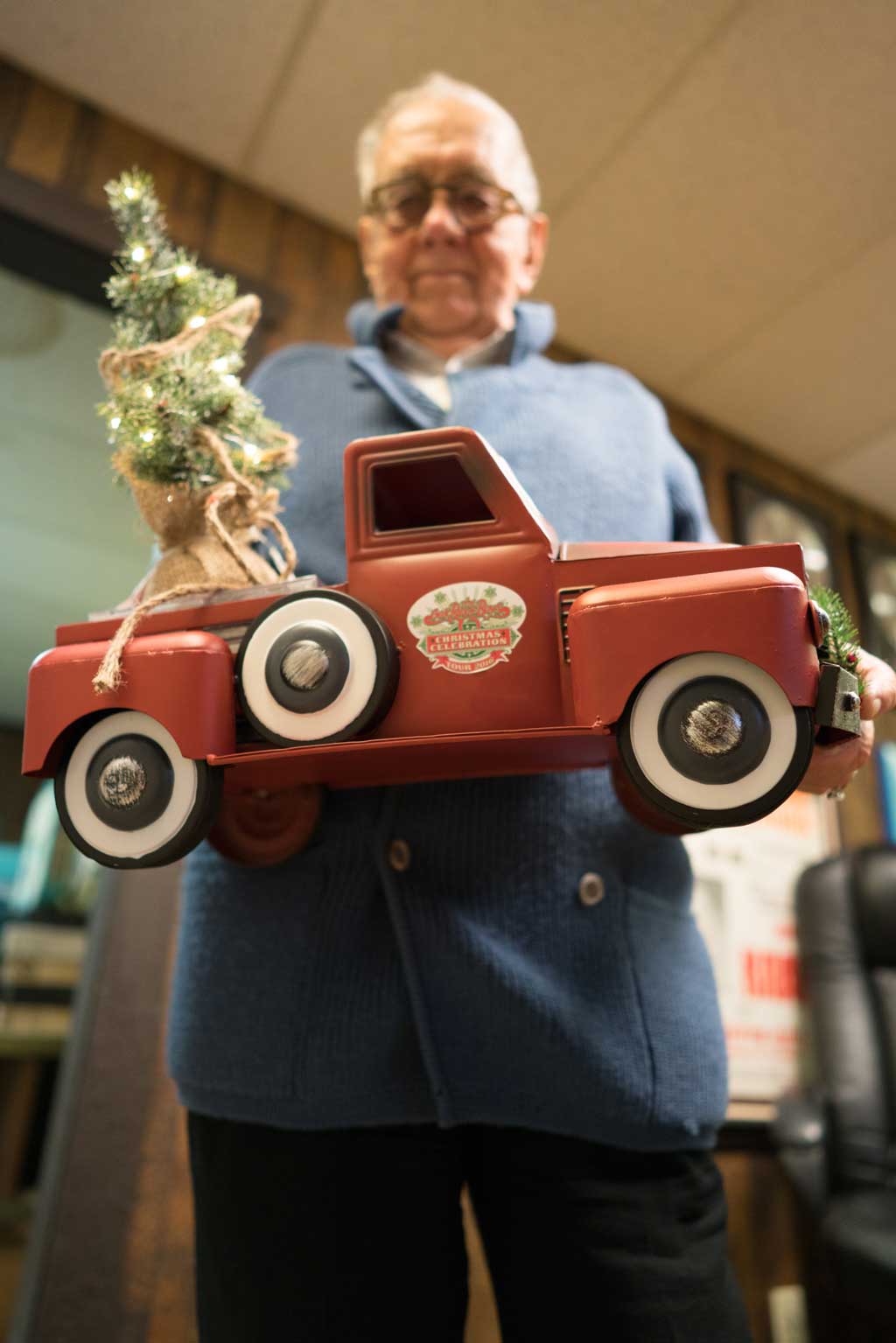
Out of the plethora of show-biz memorabilia displayed inside Jim Halsey’s seven-room office suite, the Tulsa-based country-music impresario has plucked, on this day, a retro-looking toy truck festooned with a miniature Christmas wreath.
As he talks about how “trucks are part of country music, of being together, of being with family, of farming and ranching,” it becomes clear that the little, red vehicle is a symbol for a lot of things in Halsey’s life – including his 44-year stint as manager of the venerable country act the Oak Ridge Boys.
It was Halsey who, back in the 1970s, engineered the Oaks’ transition from a straight-ahead, Southern-gospel quartet to a mainstream, country-music recording and touring act. And it’s Halsey who continues to guide their careers nearly four and a half decades later. The truck as a symbol extends to the cover of the Oaks’ latest disc, Celebrate Christmas, which prominently pictures the full-sized version of the miniature replica on Halsey’s desk.
“Kathy Harris, the Oak Ridge Boys’ marketing manager, found this,” says Halsey, picking up the customized toy. “I don’t know where. We sent them out to several executives we work with, and they really went over well.”
Halsey used the little truck he acquired as a prop for the Christmas card photo taken of him and his wife, artist Minisa Crumbo. Even in a photograph, he says, it drew attention.
“People just love the picture and the ambiance of the truck,” he says. “I think that’s because it really does represent the heart and soul of the Oak Ridge Boys.”
That heart and soul is represented by Celebrate Christmas, available nationwide in Cracker Barrel Old Country Stores, as well as at the usual brick-and-mortar stores and online. It’s not only the quartet’s latest recorded effort (and seventh yuletide disc), but the most recent indication of how vital the holiday has been to the group and its long run as a country-music attraction.
“One of the important things we’ve done since 1990 is our Christmas tours,” Halsey says. “Before we started doing the tours themselves, there would be big corporations that would have events, private parties for their employees, and they’d ask us to do some Christmas songs. It was always such a good feeling when the guys did that. And during the Christmas season, we would always add two or three [seasonal] songs [to the regular concerts].
“But then, in the early ’80s, we started doing an actual Christmas show with Kenny Rogers, and we did that for eight or nine years. Sometimes Dottie West was on with us; sometimes it was someone else. The last Christmas tour we did with Kenny, in 1989, Garth Brooks opened.
“Finally, we just said, ‘It’s getting to the point that we could fill up our own itinerary with our own Christmas tour.’And that’s what we did. We started in 1990, so this would be, what, our 27th one, this year? They’re so successful. They’re all sold out. We have the traditional Christmas songs, and the fun songs, too, and we have special sets designed that we change each year.

“One year we did a porch and a big fireplace, all that stuff. It’s a fun tour, not only for the audience but for the guys themselves. They put their heart and soul into it. A lot of the songs they do are songs they sang when they were kids, so it’s a warm and fuzzy feeling, the whole tour.”
Halsey’s office walls bear further evidence of the ongoing relationship he and the Oaks have with Christmas. There’s a big, signed poster promoting a major holiday tour that took place some years ago, as well as a gold record presented to Halsey for the Oak Ridge Boys’ 1982 LP Christmas, their first holiday album, which yielded the Top Five country hit “Thank God for Kids.”
Gold records, signifying sales of more than 500,000 units, as well as platinum records, indicating sales of more than a million, are given to artists – “and, usually as a courtesy, their managers,” by the Recording Industry Association of America, an organization that, among other things, represents the intellectual property and First Amendment rights of artists and record labels, Halsey says. The 159 other gold and platinum discs on Halsey’s wall, representing a variety of albums and artists, bear witness to his remarkable 68-year career as artist manager, booking agent and promoter.
“Those are really the centerpiece of my collection,” he says. “Those aren’t anything I went out and bought. They were given to us in recognition of the artists we represented, in appreciation for the work. There’s a big one out there from RIAA that’s quite an unusual piece. It represents the sale of 41 million records by the Oak Ridge Boys. That’s something people stop and look at.”
It’s far from the only thing. A visit to the Halsey Company offices also takes you by displays filled with one-of-a-kind items, including the Grammy that Roy Clark won in 1982 (Best Country Instrumental Performance for “Alabama Jubilee”), the jacket Lee Greenwood wore when he sang “God Bless the U.S.A.” in the White House, and, perhaps the most unusual, a pair of shoes that once belonged to former President George H.W. Bush.
“Those came from [Oak Ridge Boy] Duane Allen, who was riding on Air Force One with President Bush,” Halsey says. “President Bush said, ‘Those are interesting boots you have on. What are they?’ Duane said, ‘Lizard,’ or something, and the president said, ‘Well, let me try those on. They look like my size.’ Now, this is the president.
“So he put them on, and they fit. And he said, ‘Here. I’ll trade you,’ and gave Duane his shoes. They actually belong to Duane, but they’ll probably stay in the collection for people to see.”
The idea of people not only seeing that collection, but also benefiting from it in other ways, has been on Halsey’s mind a lot these days. Astounding as it may seem to visitors, the hundreds of posters, gold and platinum discs, signed guitars and other show-business artifacts only represent a minuscule portion of the memorabilia Halsey’s collected through his life and career, with some of the rest of it displayed in places like the Oklahoma Music Hall of Fame in Muskogee, the Kansas Celebrity Hall of Fame in Independence and the Musical Instrument Museum in Phoenix. Then there are his 60 four-drawer file cabinets “full of proposals, propositions, contracts, how-to’s, critiques and advertising materials.”
Those contain, he adds, “tons of press clippings and files that go back to 1949, when I started as a promoter. I have over 30,000 contracts in those files, from Merle Haggard to Dwight Yoakam to Tammy Wynette and Reba McEntire. In that scope of time, we’ve represented over 100 artists, 28 of whom are in the Country Music Hall of Fame.
“What I’m looking for is someone to acquire all of this, someone who recognizes its value and how it can be most appropriately used. We want to find somebody who can really use this and utilize it to the max. If someone had it as a tourist attraction, it would be entertaining. It would be inspirational. But more than anything, it would be educational. I think that’s its greatest purpose. So we are looking for a proper home for all of it.
“Maybe I would still be associated with it in some way,” concludes the octogenarian. “But my hands are really full with the Oak Ridge Boys.”

























